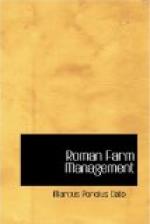[Footnote 44: Following Plato and Xenophon and Cicero, Varro cast his books into the form of dialogues to make them entertaining ("and what is the use of a book,” thought Alice in Wonderland, “without pictures or conversations."): for the same reason he was careful about his local colour. Thus the scene of this first book, which relates to agriculture proper, is laid at Rome in the temple of Earth on the festival of the Seed Sowing, and the characters bear names of punning reference to the tilling of the soil. Varro was strong on puns, avowing (Cicero Acad. I, 2) that that form of humour made it easier for people of small intelligence to swallow his learning.]
[Footnote 45: The story is that when Scipio captured Carthage he distributed the Punic libraries among the native allies, reserving only the agricultural works of Mago, which the Roman Senate subsequently ordered to be translated into Latin, so highly were they esteemed. Probably more real wealth was brought to Rome in the pages of these precious volumes than was represented by all the other plunder of Carthage. “The improving a kingdom in matter of husbandry is better than conquering a new kingdom,” says old Samuel Hartlib, Milton’s friend, in his Legacie. It is a curious fact that as the Romans derived agricultural wisdom from their ancient enemies, so did the English. Cf. Thorold Rogers’ Six Centuries of Work and Wages. “We owe the improvements in English agriculture to Holland. From this country we borrowed, at the beginning of the seventeenth century, the cultivation of winter roots, and, at that of the eighteenth, the artificial grasses. The Dutch had practised agriculture with the patient and minute industry of market gardeners. They had tried successfully to cultivate every thing to the uttermost, which could be used for human food, or could give innocent gratification to a refined taste. They taught agriculture and they taught gardening. They were the first people to surround their homesteads with flower beds, with groves, with trim parterres, with the finest turf, to improve fruit trees, to seek out and perfect edible roots and herbs at once for man and cattle. We owe to the Dutch that scurvy and leprosy have been banished from England, that continuous crops have taken the place of barren fallows, that the true rotation of crops has been discovered and perfected, that the population of these islands has been increased and that the cattle and sheep in England are ten times what they were in numbers and three times what they were in size and quality.”]
[Footnote 46: The Roman proverb which Agrius had in mind reminds one of the witty French woman’s comment upon the achievement of St. Denis in walking several miles to Montmartre, after his head had been cut off, (as all the world can still see him doing in the verrieres of Notre Dame de Chartres): “en pareil cas, ce n’est que le premier pas qui coute.”]




